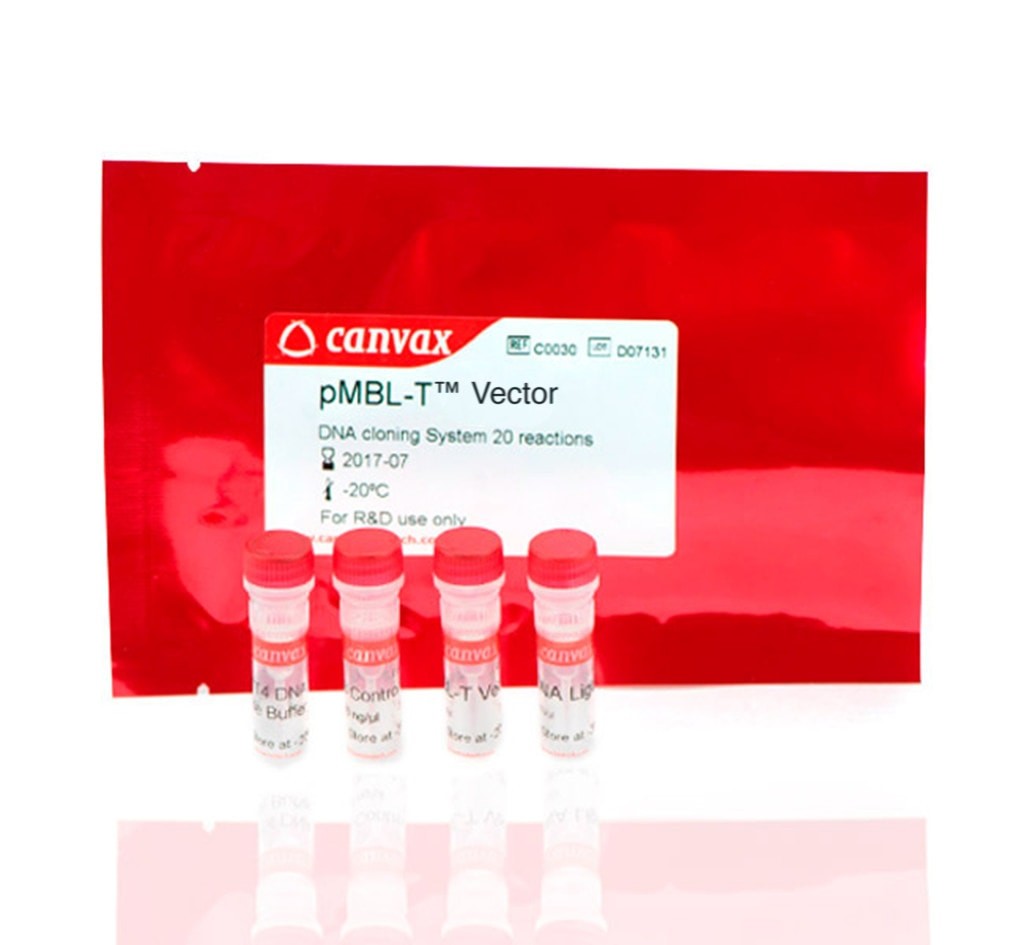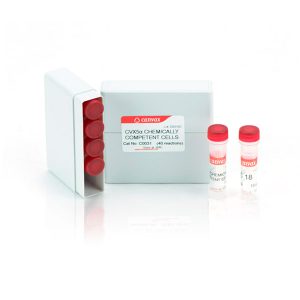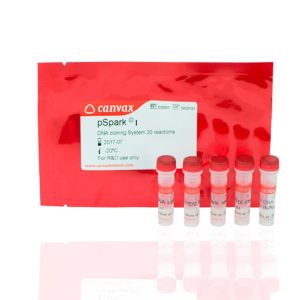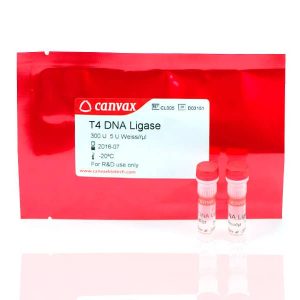pMBL™ T Vector
For a Efficient, Convenient & Fast Cloning of DNA fragments with A overhangs
pMBL™ T-Vector DNA Cloning Kit is an efficient, convenient and fast system for the cloning of PCR products. The vector is prepared by cutting pMBL™ T-Vector with EcoRV and adding a 3´ terminal thymidine to both ends. These single 3´-T overhangs at the insertion site greatly improve the efficiency of ligation of a PCR product into the plasmids by preventing recircularization of the vector and providing a compatible overhang for PCR products generated by certain thermostable polymerases such as Horse-Power™ Taq DNA Polymerase.
These Polymerases often add a single deoxyadenosine, in a template-independent fashion, to the 3´-ends of the amplified fragments.
Price: 188.31 €
Detailed information:
Advantages & Features
- Highly efficient: greater than 90% white colonies in a transformation with supplied insert control.
- Proven performance: more than 1,000 recombinant colonies expected in optimal conditions.
- Fast and easy protocol: results from 15 min protocol.
- Optimized: improve efficiency of ligation of a PCR product into the plasmid.
- Compatible: overhang for ligation of PCR products preventing recircularization of the vector.
- Designed by cutting the vector with EcoRV and adding a 3´ terminal thymidine to both ends.
Specifications
Includes
– 20 µL pMBL™ T-Vector (50 ng/µL)
– 20 µL T4 DNA Ligase (5U/Weiss)
– 100 µL T4 DNA Ligase Buffer (10x)
– 5 µL Insert Control 600 bp (30 ng/µL)
Applications
- Cloning of PCR fragments into DNA Cloning vector.
- Blue/white screening for recombinants.
Tables & Figures
t
Quality Control
- Functional test using a 600 pb PCR fragment.
Advice
Storage, Shipping & Guarantee
- Shipped in: Gel Pack.
- Storage: -20 ºC (NON Frost-Free Freezer).
Citations
- Jiménez Díaz, L. (2022). Metabolismo de ácidos grasos y síntesis de biocombustibles en” Pseudomonas putida”.
- Santamaría‐Hernando, S., De Bruyne, L., Höfte, M., & Ramos‐González, M. I. (2022). Improvement of fitness and biocontrol properties of Pseudomonas putida via an extracellular heme peroxidase. Microbial Biotechnology.
- Martins-Noguerol, R., Acket, S., Troncoso-Ponce, M. A., Garcés, R., Venegas-Calerón, M., Salas, J. J., … & Moreno-Pérez, A. J. (2022). Characterization and impact of sunflower plastidial octanoyltransferases (Helianthus annuus L.) on oil composition. Journal of Plant Physiology, 153730.
- Godoy, Patricia, et al. “Synthesis of aromatic amino acids from 2G lignocellulosic substrates.” Microbial Biotechnology.
- Jiménez Muñoz, R. (2020). Desarrollo de herramientas fisiológicas y genómicas para mejorar la calidad postcosecha del fruto de calabacín.
- Vazquez-Hernandez, M., Romero, I., Sanchez-Ballesta, M. T., Merodio, C., & Escribano, M. I. (2020). Functional characterization of VviDHN2 and VviDHN4 dehydrin isoforms from Vitis vinifera (L.): an in silico and in vitro approach. Plant Physiology and Biochemistry.
- Martins-Noguerol, R., Moreno-Pérez, A. J., Sebastien, A., Troncoso-Ponce, M. A., Garcés, R., Thomasset, B., … & Martínez-Force, E. (2020). Impact of sunflower (Helianthus annuus L.) plastidial lipoyl synthases genes expression in glycerolipids composition of transgenic Arabidopsis plants. Scientific Reports, 10(1), 1-16.
- Olmedo-Verd, E., Brenes-Álvarez, M., Vioque, A., & Muro-Pastor, A. M. (2019). A Heterocyst-Specific Antisense RNA Contributes To Metabolic Reprogramming In Nostoc sp. PCC 7120. Plant and Cell Physiology.
- Benítez Casanova, L. (2017). Caracterización de las principales enzimas celulolíticas de myceliophthora thermophila implicadas en la degradación de biomasa lignocelulósica y mejora de la hidrólisis de hemicelulosa para la producción de bioetanol de segunda generación.
- Molina-Henares, M. A., Ramos-González, M. I., Daddaoua, A., Fernández-Escamilla, A. M., & Espinosa-Urgel, M. (2016). FleQ of Pseudomonas putida KT2440 is a multimeric cyclic diguanylate binding protein that differentially regulates expression of biofilm matrix components. Research in Microbiology.
- Merino‐Puerto, V., Mariscal, V., Mullineaux, C. W., Herrero, A., & Flores, E. (2010). Fra proteins influencing filament integrity, diazotrophy and localization of septal protein SepJ in the heterocyst‐forming cyanobacterium Anabaena sp. Molecular microbiology, 75(5), 1159-1170.
- Sánchez-García, A., Moreno-Pérez, A. J., Muro-Pastor, A. M., Salas, J. J., Garcés, R., & Martínez-Force, E. (2010). Acyl-ACP thioesterases from castor (Ricinus communis L.): an enzymatic system appropriate for high rates of oil synthesis and accumulation. Phytochemistry, 71(8), 860-869.
- Rodríguez-Rodríguez, M. F., Salas, J. J., Garcés, R., & Martínez-Force, E. (2014). Acyl-ACP thioesterases from Camelina sativa: Cloning, enzymatic characterization and implication in seed oil fatty acid composition. Phytochemistry, 107, 7-15.
- Mandakovic, D., Trigo, C., Andrade, D., Riquelme, B., Gómez-Lillo, G., Soto-Liebe, K., … & Vásquez, M. (2016). CyDiv, a conserved and novel filamentous cyanobacterial cell division protein involved in septum localization. Frontiers in microbiology, 7.
- Lacal, J., Muñoz‐Martínez, F., Reyes‐Darías, J. A., Duque, E., Matilla, M., Segura, A., … & Ramos, J. L. (2011). Bacterial chemotaxis towards aromatic hydrocarbons in Pseudomonas. Environmental microbiology, 13(7), 1733-1744.
- Mariscal, V., Herrero, A., Nenninger, A., Mullineaux, C. W., & Flores, E. (2011). Functional dissection of the three‐domain SepJ protein joining the cells in cyanobacterial trichomes. Molecular microbiology, 79(4), 1077-1088.
- Vivas, A., Moreno, B., del Val, C., Macci, C., Masciandaro, G., & Benitez, E. (2008). Metabolic and bacterial diversity in soils historically contaminated by heavy metals and hydrocarbons. Journal of Environmental Monitoring, 10(11), 1287-1296.
- Espiñeira, M., González-Lavín, N., Vieites, J. M., & Santaclara, F. J. (2008). Authentication of Anglerfish Species (Lophius spp) by Means of Polymerase Chain Reaction− Restriction Fragment Length Polymorphism (PCR− RFLP) and Forensically Informative Nucleotide Sequencing (FINS) Methodologies. Journal of agricultural and food chemistry, 56(22), 10594-10599.
- López-Igual, R., Flores, E., & Herrero, A. (2010). Inactivation of a heterocyst-specific invertase indicates a principal role of sucrose catabolism in heterocysts of Anabaena sp. Journal of bacteriology, 192(20), 5526-5533.
- Muro-Pastor, A. M., Flores, E., & Herrero, A. (2009). NtcA-regulated heterocyst differentiation genes hetC and devB from Anabaena sp. strain PCC 7120 exhibit a similar tandem promoter arrangement. Journal of bacteriology, 191(18), 5765-5774.
- García, V., Godoy, P., Daniels, C., Hurtado, A., Ramos, J. L., & Segura, A. (2010). Functional analysis of new transporters involved in stress tolerance in Pseudomonas putida DOT‐T1E. Environmental microbiology reports, 2(3), 389-395.
- Pernil, R., Herrero, A., & Flores, E. (2010). Catabolic function of compartmentalized alanine dehydrogenase in the heterocyst-forming cyanobacterium Anabaena sp. strain PCC 7120. Journal of bacteriology, 192(19), 5165-5172.
- Gozalbo-López, B., Andrade, P., Terrados, G., de Andrés, B., Serrano, N., Cortegano, I., … & Gaspar, M. L. (2009). A role for DNA polymerase μ in the emerging DJH rearrangements of the postgastrulation mouse embryo. Molecular and cellular biology, 29(5), 1266-1275.
- Pérez-Montaño, F., Guasch-Vidal, B., González-Barroso, S., López-Baena, F. J., Cubo, T., Ollero, F. J., … & Espuny, M. R. (2011). Nodulation-gene-inducing flavonoids increase overall production of autoinducers and expression of N-acyl homoserine lactone synthesis genes in rhizobia. Research in microbiology, 162(7), 715-723.
- Burnat, M., & Flores, E. (2014). Inactivation of agmatinase expressed in vegetative cells alters arginine catabolism and prevents diazotrophic growth in the heterocyst‐forming cyanobacterium Anabaena. MicrobiologyOpen, 3(5), 777-792.
- Molina-Fuentes, Á., Pacheco, D., Marín, P., Philipp, B., Schink, B., & Marqués, S. (2015). Identification of the Gene Cluster for the Anaerobic Degradation of 3, 5-Dihydroxybenzoate (α-Resorcylate) in Thauera aromatica Strain AR-1. Applied and environmental microbiology, 81(20), 7201-7214.
- López‐Igual, R., Picossi, S., López‐Garrido, J., Flores, E., & Herrero, A. (2012). N and C control of ABC‐type bicarbonate transporter Cmp and its LysR‐type transcriptional regulator CmpR in a heterocyst‐forming cyanobacterium, Anabaena sp. Environmental microbiology, 14(4), 1035-1048.
- Rodríguez-Rodríguez, M. F., Salas, J. J., Venegas-Calerón, M., Garcés, R., & Martínez-Force, E. (2016). Molecular cloning and characterization of the genes encoding a microsomal oleate Δ 12 desaturase (CsFAD2) and linoleate Δ 15 desaturase (CsFAD3) from Camelina sativa. Industrial Crops and Products, 89, 405-415.
- Mariscal, V., Herrero, A., & Flores, E. (2007). Continuous periplasm in a filamentous, heterocyst‐forming cyanobacterium. Molecular microbiology, 65(4), 1139-1145.
- Jiménez-Guerrero, I., Pérez-Montaño, F., Medina, C., Ollero, F. J., & López-Baena, F. J. (2016). The Sinorhizobium (Ensifer) fredii HH103 nodulation outer protein NopI is a determinant for efficient nodulation of soybean and cowpea. Applied and Environmental Microbiology, AEM-02770.
- Moreno-Pérez, A. J., Sánchez-García, A., Salas, J. J., Garcés, R., & Martínez-Force, E. (2011). Acyl-ACP thioesterases from macadamia (Macadamia tetraphylla) nuts: Cloning, characterization and their impact on oil composition. Plant Physiology and Biochemistry, 49(1), 82-87.
- Segura, A., Hurtado, A., Rivera, B., & Lazaroaie, M. M. (2008). Isolation of new toluene‐tolerant marine strains of bacteria and characterization of their solvent‐tolerance properties. Journal of applied microbiology, 104(5), 1408-1416.
- Pernil, R., Picossi, S., Mariscal, V., Herrero, A., & Flores, E. (2008). ABC‐type amino acid uptake transporters Bgt and N‐II of Anabaena sp. strain PCC 7120 share an ATPase subunit and are expressed in vegetative cells and heterocysts. Molecular microbiology, 67(5), 1067-1080.
- Vargas, P., Felipe, A., Michán, C., & Gallegos, M. T. (2011). Induction of Pseudomonas syringae pv. tomato DC3000 MexAB-OprM multidrug efflux pump by flavonoids is mediated by the repressor PmeR. Molecular plant-microbe interactions, 24(10), 1207-1219.
- Romero, I., Vazquez-Hernandez, M., Escribano, M. I., Merodio, C., & Sanchez-Ballesta, M. T. (2016). Expression profiles and DNA-binding affinity of five ERF genes in bunches of Vitis vinifera cv. Cardinal treated with high levels of CO2 at low temperature. Frontiers in Plant Science, 7.
- Merino-Puerto, V., Herrero, A., & Flores, E. (2013). Cluster of genes that encode positive and negative elements influencing filament length in a heterocyst-forming cyanobacterium. Journal of bacteriology, 195(17), 3957-3966.
- Ortega-Galisteo, A. P., Morales-Ruiz, T., Ariza, R. R., & Roldán-Arjona, T. (2008). Arabidopsis DEMETER-LIKE proteins DML2 and DML3 are required for appropriate distribution of DNA methylation marks. Plant molecular biology, 67(6), 671-681.
- Molina, L., Duque, E., Gómez, M. J., Krell, T., Lacal, J., García‐Puente, A., … & Segura, A. (2011). The pGRT1 plasmid of Pseudomonas putida DOT‐T1E encodes functions relevant for survival under harsh conditions in the environment. Environmental microbiology, 13(8), 2315-2327.
- Corrales-Guerrero, L., Flores, E., & Herrero, A. (2014). Relationships between the ABC-exporter HetC and peptides that regulate the spatiotemporal pattern of heterocyst distribution in Anabaena. PloS one, 9(8), e104571.
- Padilla, S., Tran, U. C., Jiménez-Hidalgo, M., López-Martín, J. M., Martín-Montalvo, A., Clarke, C. F., … & Santos-Ocaña, C. (2009). Hydroxylation of demethoxy-Q 6 constitutes a control point in yeast coenzyme Q 6 biosynthesis. Cellular and Molecular Life Sciences, 66(1), 173-186.
- Aznar-Moreno, J. A., Venegas-Calerón, M., Du, Z. Y., Garcés, R., Tanner, J. A., Chye, M. L., … & Salas, J. J. (2016). Characterization of a small acyl-CoA-binding protein (ACBP) from Helianthus annuus L. and its binding affinities. Plant Physiology and Biochemistry, 102, 141-150.
Safety Statements
This product is developed, designed and sold exclusively for Research purposes and in vitro use only (RUO). The product was not tested for use in diagnostics or for drug development, nor is it suitable for administration to humans or animals. For more info, please check its Material Safety Data Sheet available in this website.
Customers Review
You may also like…
-

CVX5a™ Chemically Competent Cells
Price: 138.60 € – 345.00 € C0031Select options This product has multiple variants. The options may be chosen on the product page -

pSpark® I
Price: 175.00 € C0001Add to basket -

Horse-Power™ Taq DNA Polymerase
Price: 42.63 € P0023Add to basket -

T4 DNA Ligase (5U Weiss/µL)
Price: 118.52 € CL006Add to basket





